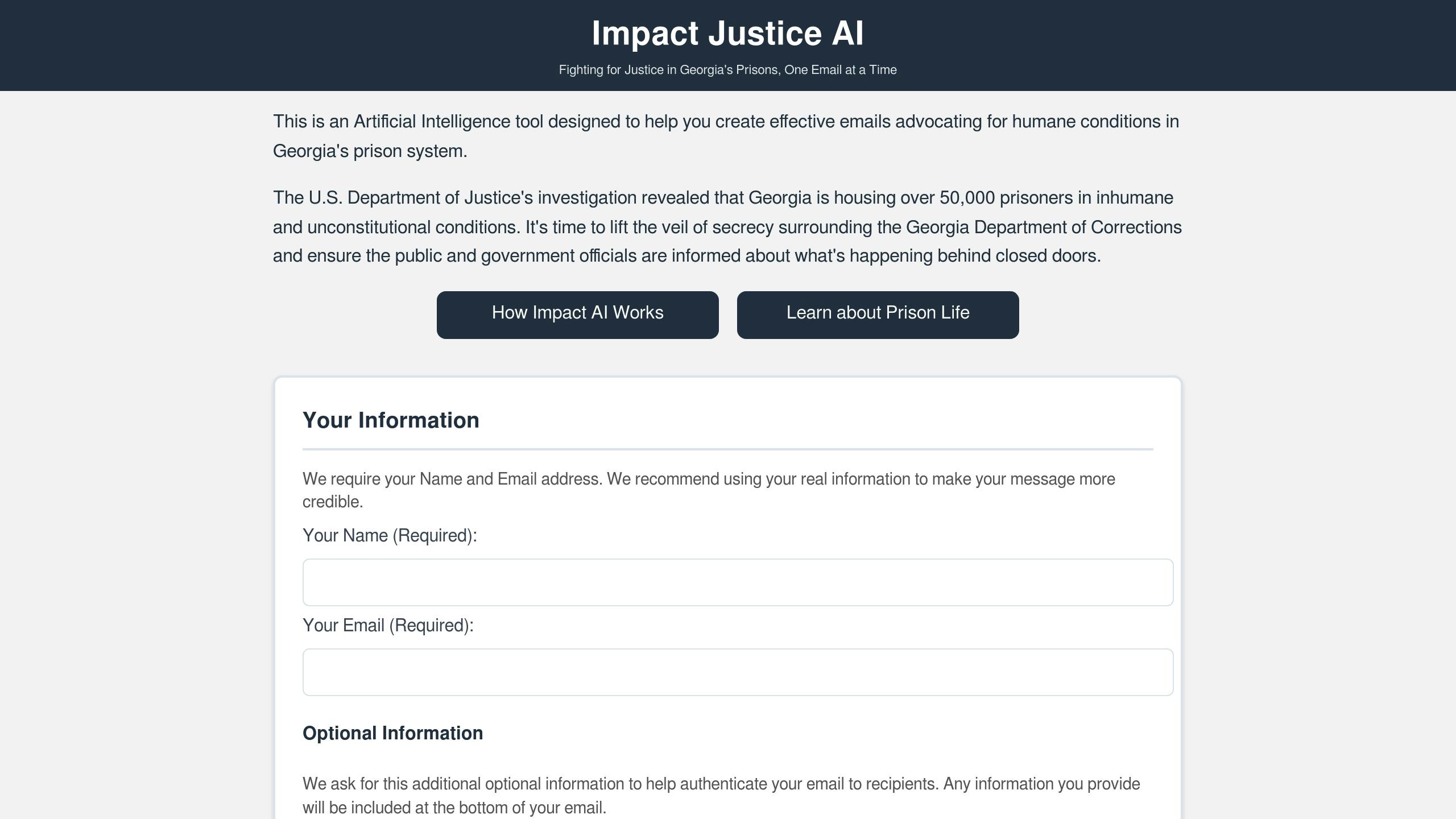Want to get media attention for prison-related stories? Here’s how:
- Start with a strong pitch: Focus on timeliness, evidence, and human-centered narratives.
- Target the right outlets: Local papers, public broadcasters, or national platforms like The Marshall Project.
- Highlight key issues: Use data and personal stories to expose systemic problems.
- Protect your sources: Ensure safety for inmates sharing sensitive information.
- Leverage AI tools: Use platforms like Impact Justice AI to streamline pitch creation and fact-checking.
Quick Overview
| Key Steps | What to Do |
|---|---|
| Find the Right Outlet | Match your story to media that already covers prison issues. |
| Craft the Pitch | Use an engaging subject line, clear evidence, and emotional appeal. |
| Use Data | Back claims with stats from DOJ reports or FOIA requests. |
| Protect Sources | Prioritize safety by using encrypted communication and pseudonyms. |
| Incorporate AI | Save time with AI tools to draft and refine your pitch. |
A great pitch combines compelling stories, verified data, and ethical practices to drive attention and reform.
Tips for Journalists: How to Report and Promote Your Untold Story
Step 1: Meeting Journalists’ Requirements
To boost your chances of getting published, make sure your pitch aligns with what journalists are looking for. Media outlets prioritize pitches that emphasize clear news values, such as timeliness, evidence, and a human-centered approach. Understanding these priorities will help you focus on the outlets most likely to respond to your story.
Finding the Right News Outlets
Georgia’s media landscape includes several outlets that report on prison-related issues. Offering exclusive information can make your pitch stand out across these various channels.
| Media Type | Key Outlets | Coverage Focus |
|---|---|---|
| Local Print/Digital | Atlanta Journal-Constitution, Macon Telegraph | Investigations into Georgia’s prison system |
| Public Broadcasting | Georgia Public Broadcasting, WABE | In-depth stories and policy analysis |
| National Media | The Marshall Project, ProPublica | Systemic issues and reform efforts |
| Trade Publications | Prison Legal News, Corrections Today | Industry-specific reporting |
Key Elements of News Stories
Once you’ve targeted the right outlet, craft your pitch to meet essential journalistic standards:
Timeliness and Impact
Stories about prisons need a current angle and a clear demonstration of why they matter. For instance, citing data like a “25% increase in suicide attempts over the past year” adds urgency and importance [7].
Evidence and Documentation
A strong pitch includes solid evidence to back up its claims. Examples of supporting materials include:
- Reports from the Department of Justice
- Results from FOIA requests
- Analyses by criminal justice experts [2]
Human Interest
Personal stories should connect to larger systemic issues. For example, you could highlight an individual’s experience to illustrate broader problems affecting many inmates [1].
“Worst conditions I’ve seen in 20 years” – Pairing expert testimony with data, such as ‘40% of Georgia inmates lack access to essential mental health services,’ creates a powerful narrative for journalists [7].
Journalists are more likely to pick up stories that offer exclusivity or a fresh perspective. If possible, provide access to sources others haven’t interviewed, such as whistleblowers or families who haven’t shared their experiences publicly [4].
Step 2: Writing Clear Prison Story Pitches
Linking Personal Stories to Larger Issues
Effective pitches tie personal experiences to broader systemic problems. When sharing individual stories, focus on details that reveal institutional failures. For instance, you might describe a case where an untreated infection escalated to hospitalization, illustrating the delays or denials of medical care many inmates endure [7]. A strong narrative combines emotional appeal with solid data. Once you’ve set the personal story, back it up with reliable data to highlight the larger issue.
Incorporating Facts and Statistics
Context is key when presenting statistics. Compare current figures to historical data or national averages to highlight trends. Use official reports to show issues like overcrowding or declining access to basic services. Translate numbers into relatable terms to make the human impact clear. These elements will help you craft a concise and impactful pitch email.
Structuring the Pitch Email
Your pitch email should be short and to the point. Start with a subject line that conveys urgency and grabs attention, such as:
“Exclusive: Whistleblower reveals 40% of Georgia prison guards lack proper training” [8].
Organize the email into three short paragraphs:
- Opening Hook
Start with your strongest point, whether it’s exclusive data, a powerful personal story, or a timely event. For example:
“A former Georgia prison administrator has shared internal documents exposing widespread failures in staff training, directly linked to three inmate deaths in 2024.” - Context and Evidence
Follow up with specific facts and expert analysis.“The conditions in Georgia’s prisons go beyond humanitarian concerns – they’re a public safety crisis. Research indicates that every dollar invested in prison education programs saves five dollars in recidivism costs” [7].
- Call to Action
Attach relevant documents, like training records or a DOJ report, and invite the recipient to schedule a discussion at their convenience.
Tools like Impact Justice AI can help you organize your pitch and pinpoint data that resonates with journalists. A clear, data-driven approach ensures personal stories are tied to the systemic issues that demand public attention.
Step 3: Tools for Better Pitches
Impact Justice AI: AI-Powered Advocacy

Impact Justice AI is designed to help create impactful messages about Georgia prison reform by combining Department of Justice (DOJ) reports, investigative journalism, and personal stories. The platform focuses on connecting individual experiences with broader systemic issues.
Some of its standout features include:
- DOJ Report Integration: Automatically incorporates statistics and findings from official investigations.
- Topic Customization: Lets users tailor pitches to specific issues like healthcare access or facility conditions.
- Local Context Analysis: Provides Georgia-specific data and policy insights.
- Evidence Framework: Recommends relevant case studies and expert sources.
A 2023 survey by Cision found that 43% of PR professionals are already using or planning to adopt AI for media pitching [2]. This shift highlights the growing role of AI in advocacy efforts.
Manual vs. AI Pitch Methods
Traditional pitching often involves lengthy research and detailed personalization, whereas AI tools can produce a well-structured first draft in much less time. For example, Edelman’s 2023 research showed that AI tools reduced preparation time by 30% and increased journalist response rates by 15% [9]. However, while AI speeds up the process and organizes data effectively, human input is still needed to ensure accuracy and add a personal touch.
Best practices for blending AI and human expertise:
- Double-check AI-generated statistics and claims about prison conditions.
- Incorporate personal insights that AI might miss.
- Adjust the tone to fit the preferences of the specific journalist or outlet.
- Use AI-generated drafts as a starting point and refine them to reflect your unique perspective.
Step 4: Ethics and Standards
Once you’ve built your pitch with strong evidence and personal stories, it’s time to focus on ethical practices. Protecting your sources and ensuring accuracy are just as important as crafting engaging content.
Source Safety Guidelines
When covering prison stories, keeping your sources safe is critical. The risks are real – take the April 2023 case from the ACLU of Michigan, where Demetrius Buckley, an incarcerated writer, reportedly faced retaliatory assaults after his work was published [8]. To minimize risks, follow these steps:
- Use encrypted messaging for all communications.
- Keep identification details separate from story content.
- Avoid sensitive discussions over prison email systems.
- Use pseudonyms and avoid including specific dates or locations.
- Get explicit, informed consent on how the story will be used.
- Let sources review their content before submission.
Fact-Checking AI Content
Even with your pitch ready, fact-checking is non-negotiable. AI tools like Impact Justice AI can help streamline the process, but you still need to verify every detail. A 2022 survey found that 55% of journalists now use AI tools in their work [5].
| Step | Process | Goal |
|---|---|---|
| Cross-Reference | Compare data with DOJ reports and studies | Confirm the accuracy of stats and claims. |
| Expert Review | Consult criminal justice specialists | Ensure proper context and interpretation. |
| Source Verification | Trace original data sources | Verify relevance and accuracy. |
| Bias Assessment | Check for potential AI biases | Keep reporting fair and balanced. |
Maintaining Objectivity
Once you’ve verified the facts, make sure your reporting stays impartial. A recent study revealed that 78% of journalists view objectivity as “extremely important” to their work [6].
To maintain fairness, present multiple viewpoints using neutral language. Support your claims with solid evidence and clearly distinguish between factual reporting and advocacy. Transparency about your advocacy goals can actually build trust – always back your claims with primary data and sources to strengthen credibility.
Conclusion: Steps for Success
Creating an effective pitch about prison reform requires blending powerful storytelling with a strong ethical foundation. This approach not only informs but also inspires action toward meaningful change.
Media’s Role in Prison Reform
The media plays a key role in driving prison reform by spotlighting systemic problems and holding institutions accountable. A well-prepared pitch can amplify individual stories while connecting them to larger policy discussions.
Here are some strategies to consider:
- Use verified data and credible reports to back your pitch.
- Link personal stories to broader systemic challenges.
- Utilize both traditional and digital media platforms for wider reach.
- Always prioritize the safety and privacy of your sources while adhering to ethical standards.
As mentioned earlier, combining data-driven storytelling with a focus on source protection strengthens your pitch. AI tools can also be helpful for refining your message [3].
Keep in touch with journalists covering criminal justice, tie your pitch to relevant news, and remain persistent and professional [4].
An impactful pitch doesn’t just tell a story – it becomes part of a larger conversation that pushes for real reform.
FAQs
How do you pitch an investigative story?
When pitching investigative prison stories, focus on presenting clear evidence and emphasizing the human impact.
Key Elements of a Strong Pitch
To make your investigative pitch stand out, include the following:
- A compelling and attention-grabbing hook
- Verified data backed by trustworthy sources
- Measures to protect any vulnerable sources
- A fresh perspective or angle
- A timeline that’s achievable and realistic
For instance, in 2022, freelance journalist Keri Blakinger successfully pitched a story about solitary confinement in Texas prisons to The Marshall Project, demonstrating the importance of clarity and a human-centered approach.
Building Relationships with Journalists
Establishing strong connections with journalists can significantly improve your chances of a successful pitch. Here’s how:
| Strategy | How to Implement | Outcome |
|---|---|---|
| Follow Their Work | Stay updated on their coverage and engage thoughtfully | Understand their focus and style better |
| Provide Value | Share useful tips or sources, even outside of pitching | Position yourself as a reliable contact |
| Respect Boundaries | Allow 1-2 weeks before following up on your pitch | Build trust and maintain professionalism |
These relationships can be nurtured further by incorporating modern tools into your process.
Leveraging Tools and Technology
Modern tools can make pitching more efficient. For example, AI tools like Impact Justice AI can help draft your messages, ensuring accuracy and impact.
